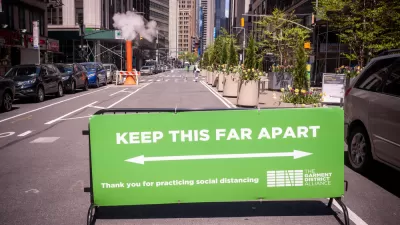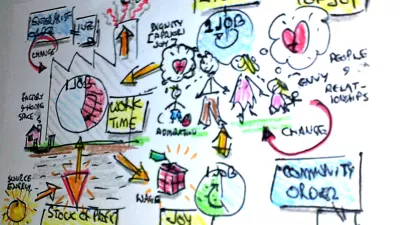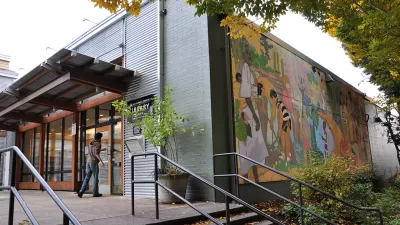Some people choose to work in planning because they see it as a relatively interesting and stable job. Others have dreams of being the equivalent of an all-powerful SimCity-style mayor. However, many choose planning as a career because they want to make a difference in the world. They want to do good and to help those who are the least advantaged. They are attracted by the potential, if limited, for planning to foster environmental justice and social equity.
Some people choose to work in planning because they see it as a relatively interesting and stable job. Others have dreams of being the equivalent of an all-powerful SimCity-style mayor. However, many choose planning as a career because they want to make a difference in the world. They want to do good and to help those who are the least advantaged. They are attracted by the potential, if limited, for planning to foster environmental justice and social equity.
But figuring out the best strategies for doing good can be a bit complicated, particularly for students entering the field. One can certainly read widely and discuss issues with local peers. However, several groups provide larger networks for learning about these issues, debating straegy, and finding support. In the U.S., three of the longer-running groups--established in the 1970s and 1980s--are particularly important.
Architects, Designers, and Planners for Social Responsibility (ADPSR), established in the early 1980s, is a network of professionals interested in social issues from opposition to war to green building. A current project is organizing architects to boycott prision design work. Its main chapters are in New York and the Bay Area. Many members are architects in fairly traditional private practices who want to meet others with social concerns, although as the name indicates, their membership extends beyond this group. They have a web site, local list serves and events, and an affiliated book publisher New Village Press.
The Association for Community Design (ACD) was founded in 1977 as a network of community design and neighborhood plannning centers. The organization is still dominated by those groups of folks who are making a difference rather than just talking about change. Their focus on action and not just criticism is impressive. Members are particularly interested in affordable housing and participatory design. While many members are architects, planners can feel at home given the non-profit and participatory focus. They have a web site and annual conferences.
Planners Network (PN) members are planners and activists interested in social and environmental justice. Founded by Chester Hartman in 1975, PN has a web site, quarterly magazine--Progressive Planning, monthly e-newsletter, chapters, and annual conferences. A disorientation guide provides information for students. Members are a mix of planning students, academics, professionals, and community activists. Unlike ADPSR and ACD where the design fields are dominant, the focus of PN is on planning, if broadly defined. The organization issues statements on issues such as the war in Iraq and the Israeli Wall.
In 2007 these three groups held coordinated conferences in New Orleans and Baton Rouge with sponsorship from Planetizen (thanks!).
Of course there are other organizations. There has been a recent trend for architects to form groups interested in disaster relief and many have attracted planning students. Some divisions of the American Planning Association--particulary Planning and the Black Community, GALIP, Planning and Women, Latinos and Planning, and Indigenous Planning also deal with some of the same topics and concerns. However, PN, ACD, and ADPSR have a long tradition of being independent voices for social change. For planning students, and others, interested in making a difference they can provide important support.
Ann Forsyth is on the Editorial Board of Planners Network and the Board of the Association for Community Design. Over the years has been a member of a majority of the organizations and APA divisions mentioned in this blog. This is the first part of a two-part blog.

Maui's Vacation Rental Debate Turns Ugly
Verbal attacks, misinformation campaigns and fistfights plague a high-stakes debate to convert thousands of vacation rentals into long-term housing.

Planetizen Federal Action Tracker
A weekly monitor of how Trump’s orders and actions are impacting planners and planning in America.

San Francisco Suspends Traffic Calming Amidst Record Deaths
Citing “a challenging fiscal landscape,” the city will cease the program on the heels of 42 traffic deaths, including 24 pedestrians.

Half of Post-Fire Altadena Home Sales Were to Corporations
Large investors are quietly buying up dozens of properties in Altadena, California, where a devastating wildfire destroyed more than 6,000 homes in January.

Opinion: What San Francisco’s Proposed ‘Family Zoning’ Could Really Mean
Mayor Lurie is using ‘family zoning’ to encourage denser development and upzoning — but could the concept actually foster community and more human-scale public spaces?

Jacksonville Launches First Autonomous Transit Shuttle in US
A fleet of 14 fully autonomous vehicles will serve a 3.5-mile downtown Jacksonville route with 12 stops.
Urban Design for Planners 1: Software Tools
This six-course series explores essential urban design concepts using open source software and equips planners with the tools they need to participate fully in the urban design process.
Planning for Universal Design
Learn the tools for implementing Universal Design in planning regulations.
Gallatin County Department of Planning & Community Development
Heyer Gruel & Associates PA
JM Goldson LLC
City of Camden Redevelopment Agency
City of Astoria
Transportation Research & Education Center (TREC) at Portland State University
Jefferson Parish Government
Camden Redevelopment Agency
City of Claremont






























